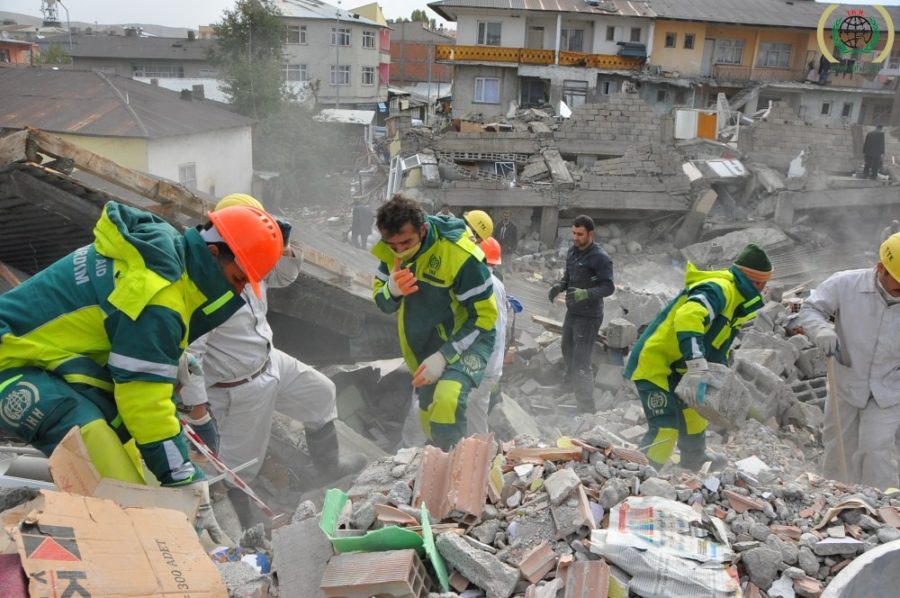In recent months, earthquake-prone Turkey has faced the largest disaster that it has seen in about eighty years. At 4:17 a.m. on February 6, an earthquake with a 7.8 magnitude struck southern Turkey along the border of Syria. Just nine hours later, a magnitude 7.5 quake transpired in Turkey’s southwest. An upwards of 50,000 civilians were killed in this brief timespan, with many cities in overwhelming disrepair. Throughout the month of February, a slew of intense earthquakes have affected Turkey and neighboring countries, most notably Syria.
For decades, experts have anticipated a high-magnitude earthquake to hit the region. Twenty years ago, leading earthquake specialist John McCloskey predicted the area in which a massive earthquake would likely strike; the only question was when. According to Nature.com, “The answer came last month, when a magnitude-7.8 shock hit the precise location that McCloskey and his team had identified.”
The rapidly shifting tectonic plate in which the Arabian Peninsula sits is primarily responsible for the recent disaster. Michael Steckler of Columbia University delineates how “Arabia has slowly been moving north and has been colliding with Turkey, and Turkey is moving out of the way to the west.” The geographical tensions of Turkey and Syria reveal that a tremor of such magnitude was long overdue, as the region has remained relatively calm for nearly a century.
In coordination with the Disaster and Emergency Management Presidency (AFAD) and the Turkish Red Crescent, the largest humanitarian organization in Turkey, the Turkish government has acted quickly following the February 6th earthquake. Upon declaring a level-4 emergency, these authorities have requested international assistance.
Many countries, including the U.S., have been eager to deliver aid in the form of search-and-rescue squads, emergency medical teams, and structural engineers. These individuals have arrived on site to remove the mounds of debris and retrieve victims who have been trapped in the rubble for several days. Rescue volunteer Mike Leum of the Los Angeles County Sheriff’s Department tells Independent that the destruction was “immense and widespread. Frequently we were just removing debris buckets at a time.”
Although Turkey has recently enforced seismic codes to prevent cities from collapse during a disaster, older buildings are nevertheless susceptible to wreckage. Even so, Steckler proposes that some newer buildings may not be up to proper code and at high risk of collapse, stating that particularly “in Istanbul, there’s a lot of illegal construction that goes on.” As of March 1, the UN has reported that over 200,000 buildings, housing both offices and apartments, have been destroyed in the earthquakes.
According to the CDP, Syria has one of “the largest humanitarian crises in the world…In northwest Syria, 4.1 million people depend on humanitarian assistance, the majority of whom are women and children.” With the health and welfare of the population already at risk, the earthquakes along their border will only lead to more destruction and heighten the fear felt by Syrian citizens.
Authorities are uncertain about the extent of the damage, unable to provide a solid forecast for the fate of the region and its people. “[The death toll] will be closer to 100,000 when the dust settles,” Professor McCloskey further predicts that they might never know, “I don’t think we will ever know.” In regards to the rubble-stricken cities, the UN expects the destruction to exceed $100 billion.
Many experts have interpreted these earthquakes as a warning to the future of the U.S. Pacific Coast. This “strike-slip” behavior, which Steckler explains as “two pieces of the Earth are sliding horizontally past each other” resembles the San Andreas fault in California. U.S. scientists and engineers expect a tremor similar to that in Turkey, as Independent reveals that these experts are “closely studying February’s earthquakes for lessons about how to prepare for the next West Coast ‘big one.’” With an earthquake likely on the horizon for the U.S., the data that was gathered from the recent Turkey disaster will provide essential information for controlling the levels of damage and ultimately save many lives.














Bebe Zevin • Mar 29, 2023 at 9:04 pm
Impressive reporting on such a tragic event. Thank you for writing about it.
Taylor • Mar 29, 2023 at 6:08 pm
Impressive work as always, gigi
Matisun Barton • Mar 29, 2023 at 4:32 pm
Very well written and very informative. Thank you for writing about this heartbreaking situation as they need our continued prayers in the devastating aftermath.